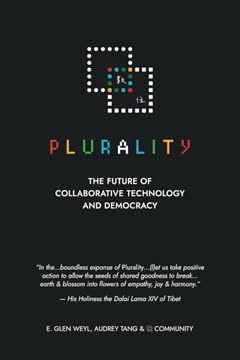Key Takeaways
1. Plurality: Technology for Infinite Diversity in Infinite Combinations.
Plurality captures the symbiotic relationship between democracy and collaborative technology.
A widening gulf. Modern information technology, particularly artificial intelligence and blockchains, has inadvertently widened the gap between technology and democracy. AI often centralizes control, while blockchain can turbo-charge atomized polarization and financial capitalism, both corrosive to democratic pluralism. This has led to widespread anxiety, with technology increasingly seen as a threat to democratic values and a tool for authoritarianism.
Beyond monist atomism. The book introduces "Plurality" (represented by the Unicode character ⿻) as "technology for collaboration across social difference," contrasting it with the "monist atomism" that underpins both Technocratic and Libertarian ideologies. This philosophy posits that the social world is not merely isolated individuals or a monolithic whole, but a rich fabric of diverse, intersecting affiliations that define both personal identities and collective organization. It draws inspiration from modern complexity science, which views reality as a network of processes rather than a collection of things.
Harnessing diversity. Plurality is a prescriptive vision for digital technology to build "engines that harness and avoid conflagration of diversity," much like industrial technology harnessed physical fuels. It aims to convert the potential energy driving social conflicts into productive work, fulfilling the ideal of "Infinite Diversity in Infinite Combinations." This approach is deeply rooted in philosophical traditions that emphasize the power of diversity as a fuel for social progress, rather than a source of inevitable conflict.
2. Taiwan: A Real-World Model of Digital Democracy's Resilience.
This capacity to harness technology and social organization to channel widely divergent attitudes towards shared progress was most sharply manifested in the decade of work following the Sunflower movement.
A place of convergence. Taiwan, a small island nation at a global crossroads, serves as a compelling living example of digital democracy in action. Despite its complex history of diverse cultures and political upheavals, Taiwan has demonstrated remarkable resilience, achieving high voter turnout, religious diversity, and a leading role in advanced chip manufacturing. Its successful, lockdown-free COVID-19 response and calm 2024 election amidst sophisticated disinformation campaigns highlight its unique capacity for collaborative diversity.
Civic hacking in action. Taiwan's digital democracy is deeply rooted in its "g0v" (gov-zero) civic hacker community, which emerged from discontent with government digital services. This "nobody movement" built alternative, open-source versions of government websites, often leading to their official adoption. The 2014 Sunflower Movement, where g0v played a crucial role in broadcasting and documenting civic actions, further solidified this model of government-civil society collaboration.
Augmented public participation. Initiatives like vTaiwan and Join platforms, utilizing tools like Polis (a machine learning-based "wikisurvey"), have enabled large-scale public deliberation on policy issues, leading to legislative action. The Presidential Hackathon further institutionalized mixed teams of civil servants, academics, and activists to solve civic problems, using Quadratic Voting to prioritize projects. These efforts demonstrate how technology can foster an "overlapping consensus" on pluralism, freedom, and anti-authoritarianism, making Taiwan a global exemplar of digital democracy.
3. Digital Rights: The Foundational Operating System for a Plural Society.
If rights are to have any meaning in our digital world, this has to change.
Rights as operating systems. Just as human rights underpin democratic life, digital operating systems (OSs) form the foundation of digital interactions. Both define the "possibility space" for action, are dynamic and adaptive, and require constant defense to maintain integrity. However, traditional rights and OSs often operate on a "monist atomist" view, treating individuals as isolated units, which clashes with the networked reality of human society.
Beyond rigid frameworks. The book argues that Libertarianism's rigid, individualistic rights and Technocracy's objective-function-driven systems fail to capture the dynamic, relational nature of human interaction. A ⿻ society requires an OS that reflects its inherent complexity, where rights are understood as emerging from and protecting diverse, intersecting social groups and people. This means moving beyond simplistic frameworks for property, identity, and democracy.
Missing layers of the internet. The original vision for the internet included fundamental protocols for identity, communication, commerce, property, and access, which were largely left unbuilt or privatized. This absence has led to a digital world where basic affordances are controlled by a few powerful entities, undermining digital freedom. Reclaiming these "missing layers" through open, non-proprietary protocols is crucial for building a truly ⿻ digital society.
4. Reimagining Identity and Association for Contextual Trust.
What we are after, therefore, is not well-described by the term “privacy”. It is about information remaining in the social setting for which it was intended, what leading privacy scholar Helen Nissenbaum calls “contextual integrity”.
The paradox of digital identity. While identity systems are crucial for digital life, current approaches often create a stark trade-off between establishing identity and protecting privacy. Government-issued IDs are canonical but offer poor privacy due to widespread use, while corporate single sign-on (SSO) systems provide rich profiles but enable extensive surveillance. Centralized biometric systems, like India's Aadhaar or Worldcoin, offer scale but risk unprecedented surveillance or vulnerability to account theft if privacy is too strictly enforced.
Identity as an intersection. A ⿻ approach to identity recognizes that personal identity is fundamentally social and relational, arising from shared histories and interactions within diverse groups. This "faceted identity" offers a path to secure and private identification through:
- Comprehensiveness and redundancy: Leveraging multiple social "vouchers" for information.
- Contextual integrity: Ensuring information stays within its intended social setting.
- Progressive authentication: Adapting verification based on required security levels.
- Social recovery: Relying on trusted relationships to recover lost credentials.
Freedom of association in the digital age. Just as individual identity is relational, so too is the freedom of association. Associations require "common knowledge" – a shared understanding and belief among members – and protection from external surveillance to maintain their integrity. New networking standards, combining tools like distributed ledger technologies (DLTs) for common belief and advanced cryptography (e.g., Zero-Knowledge Proofs, Designated Verifier Proofs) for contextual privacy, can enable "⿻ publics" where diverse communities can flourish with strong internal common beliefs shielded from outsiders.
5. Social Markets: Unlocking Collective Value Beyond Traditional Capitalism.
In short, perhaps the greatest paradox of global capitalism is that it is at once the largest scale example of collaboration and yet has trouble precisely supporting the forms of technological collaboration that it heralds.
Capitalism's paradox. While global capitalism excels at large-scale coordination and material progress, its underlying assumptions of private goods and decreasing returns limit its ability to support "supermodular" collaboration—where the whole is greater than the sum of its parts. This leads to under-provision of public goods, market power, unaddressed externalities, and inequality. Traditional responses like antitrust or regulation often introduce rigidity or fail to scale.
Beyond traditional funding. The book proposes "social markets" as a radical alternative, exemplified by platforms like GitCoin Grants. These platforms use "plural funding" formulas, like quadratic funding, to match small, diverse contributions with larger pools of sponsor funds, giving greater weight to broad community support than to large individual donations. This mechanism effectively funds open-source software and other public goods by recognizing the collective value created by distributed participation.
Reimagining property and value. Social markets extend to new forms of property and value. "Partial common ownership" schemes, like those used for land in Taiwan or NFTs, allow owners to self-assess property value under penalty of sale, encouraging productive use and broader access. The concept of "economies of esteem" replaces transferable money with quantitative markers of social capital (badges, followers), which can partly interoperate with broader markets. These innovations aim to create flexible market forms that support diverse human relationships and emergent social forms, rather than undermining them.
6. Post-Symbolic Communication: Deepening Human Connection and Empathy.
Temporal conversation with aging, experiences of proprioceptive, non-symbolic communication today are ubiquitous and include mediation, psychedelics, religious experience, romantic intimacy, dance, yoga, combat, and sports.
Beyond words and symbols. Post-symbolic communication, a concept pioneered by Jaron Lanier, explores direct, immersive shared experiences that harness all senses, including proprioception (the internal sense of one's body). This "higher-bandwidth communication" is correlated with deep human bonding and understanding, as seen in practices like dance, combat, or romantic intimacy. It offers a path to transcend the limitations of language and symbols, fostering profound empathy.
Technological frontiers. Emerging technologies like neural interfaces (Brain-Computer Interfaces or BCIs), haptic feedback, 3D audio, and wearable physiological trackers are expanding the possibilities of post-symbolic communication. These advancements could enable the direct transmission of thoughts, emotions, and sensory experiences between minds, revolutionizing interpersonal connections, education, and even therapy. Imagine experiencing a child's imagination or a warring group's pain directly.
Risks and balance. While promising deeper connection, post-symbolic communication carries risks of lost individuality, surveillance, homogenization, and disconnection from physical reality. The book warns against a "Matrix"-like dystopia where thoughts are manipulated and inner worlds vanish. To preserve privacy, autonomy, and diversity, it emphasizes the need to balance these high-bandwidth interactions with lower-bandwidth, structured forms of communication like markets and voting, which offer manageability and interpretability.
7. Augmented Deliberation: Cultivating Collective Wisdom Across Divides.
Instead of prioritizing notes that are supported by a biased, like-minded cluster of users, the system rewards notes that are supported by diverse groups of users, correcting biases driven by political and social fragmentation.
Bridging echo chambers. Social media algorithms often entrench divisions by prioritizing engagement within "echo chambers." Augmented deliberation aims to redesign these systems to "bridge" diverse perspectives, as exemplified by X's Community Notes. This platform rewards "helpful" notes supported by diverse groups of users, rather than just popular ones, encouraging the exploration of varied political information and fostering consensus across divides.
Enhancing human conversation. The book explores how technology can transform conversations into powerful engines for amplifying and connecting diverse perspectives. Tools like Polis (used in Taiwan's vTaiwan system) allow users to submit short responses, which are then clustered to highlight common attitudes and "bridging" statements that receive assent across dividing lines. This approach combines the participatory nature of social media with features that encourage thoughtful listening and the emergence of shared understanding.
Frontiers of collective intelligence. Future advancements in augmented deliberation, particularly with Generative Foundation Models (GFMs), promise to address the "broad listening" problem. GFMs could condense complex conversations, make them legible to diverse participants, and identify rough consensus or productive conflict. This could lead to dynamic, adaptive representation systems that move beyond fixed demographics, potentially even allowing GFMs to act as "collective representatives" for communities, natural features, or future generations, translating their "voices" into human-understandable terms.
8. Adaptive Governance: Dynamic Systems for Collective Action.
In short, it is not hard to see a future of truly ⿻ workplaces, embracing and harnessing collaboration across a wide range of internal and external diversity to achieve a more productive and inclusive future.
Beyond rigid bureaucracy. Traditional administration and bureaucracy, while aiming for fairness, often suffer from rigidity (insensitivity to nuance) and complexity (inscrutability, excessive discretion). These flaws limit their ability to adapt to diverse contexts and foster broad cooperation. The book argues that advances in digital technology, especially Generative Foundation Models (GFMs), can alleviate these trade-offs, allowing more diverse groups to cooperate in administrative systems while respecting their ways of life.
GFMs for flexible administration. GFMs offer the tantalizing prospect of processing diverse, unstructured inputs and adapting to them like a knowledgeable expert, but at scale and with reproducibility. This can improve access to public services for marginalized communities, enhance legal advice for the underserved, and broaden hiring pools beyond conventional career paths. These tools can "translate" complex information across social and cultural contexts, making administrative systems more responsive and inclusive.
Dynamic and inclusive structures. The future of adaptive administration could see the replacement of rigid credentials with diverse "badges" that reflect granular skills, mirroring neural network structures and allowing GFMs to process complex CVs. More ambitiously, GFMs could facilitate "cultural translation" between diverse legal systems, preserving traditional practices while enabling interoperability. This would empower diverse experimentation with novel and traditional practices, fostering "infinite diversity in infinite combinations" in governance itself.
9. Plurality's Promise: Revolutionizing Work, Health, Media, and Learning.
If we can address these social and intersubjective threats to health as effectively as we have the atomistic ones, we can easily add another 20 years to human life expectancy in the next century.
Transforming the workplace. Plurality can revolutionize formal work by strengthening remote teams through immersive shared reality (ISR), enabling co-design of inclusive corporate campuses, and making meetings more efficient and inclusive via augmented deliberation. It can also foster "⿻ hiring" by leveraging social identity systems and LLMs to access diverse talent, and support "intrapreneurship" by aligning wisdom and influence through ⿻ funding and governance, potentially boosting global GDP by 10% and growth rates.
Extending healthy life. In health, Plurality moves beyond atomistic disease treatment to a "relational concept of health." It proposes "health production societies" and "health impact tokenization" to address financing gaps and incentivize equitable benefit sharing for collective health outcomes. Post-symbolic communication and ISR can enhance medical training and therapy, while GFMs and data sharing can accelerate diagnosis and treatment by leveraging vast, diverse datasets while preserving privacy.
Reinventing media and learning. Plurality can heal media divides by enabling "walking in others' shoes" through ISR, fostering "citizen co-journalism" with GFM-assisted narrative crafting, and securing sources cryptographically. It can reshape attention allocation towards "stories that bring us together" and shift funding to "⿻ public media" sponsored by diverse communities. In learning, it promotes "resilient learning systems" like Taiwan's, fosters "diverse and collaborative learning networks" (e.g., FutureLearn, Minerva, Moedict), and envisions "globally connected lifelong learning" where AI bridges cultural norms and gamified environments foster "infinite games" of co-creation.
Last updated:
Review Summary
Plurality receives mixed reviews, with an average rating of 3.53/5. Readers appreciate its visionary ideas on digital democracy, collective intelligence, and technological solutions for governance. The book's exploration of Taiwanese digital tools and community principles is praised. However, some find it overly optimistic and repetitive. Critics note the audiobook's poor quality and suggest the content could be condensed. Despite these criticisms, many readers find value in the book's innovative concepts for improving democratic participation and leveraging technology for societal benefit.
Similar Books
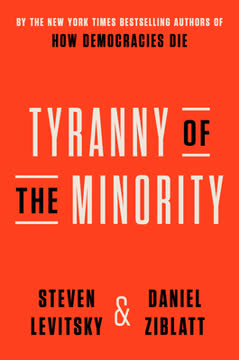


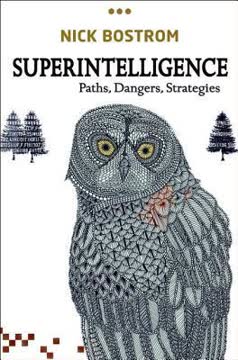


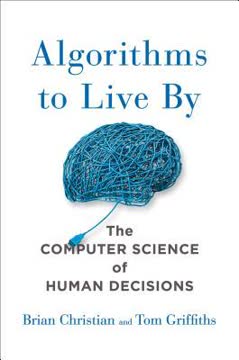
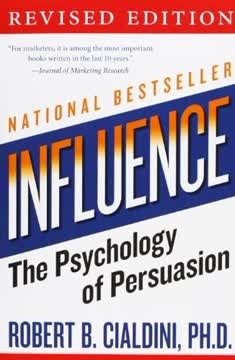


Download PDF
Download EPUB
.epub digital book format is ideal for reading ebooks on phones, tablets, and e-readers.
